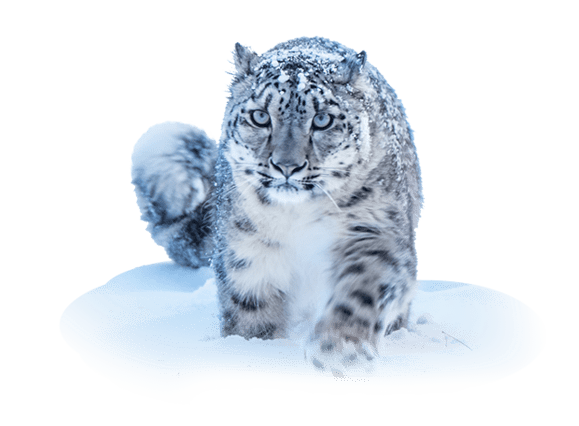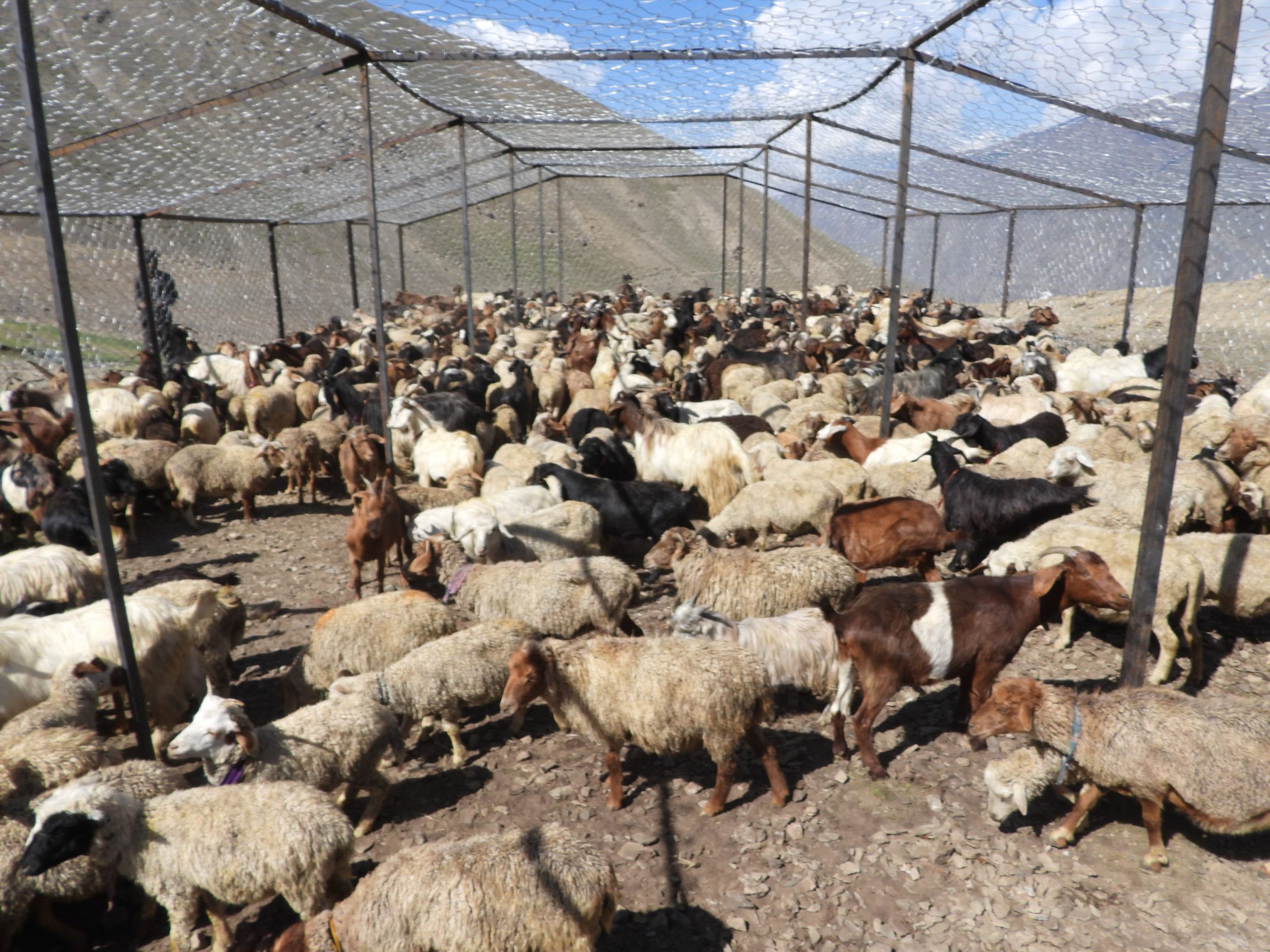Snow leopards are threatened species that live in only 12 countries in the whole world. Kyrgyzstan has emerged as a global leader in snow leopard conservation, and its people are proud of their association with the snow leopard, culturally as well as ecologically. Although snow leopards are mostly elusive, they occasionally come in contact with people and livestock. In order to ensure the safety of both livestock and snow leopards, we have gathered the most up-to-date information based on sound scientific knowledge about what to do if you encounter a snow leopard. In most cases, the best strategy is to leave the animal alone and to give them space. Thank you for caring for the snow leopards.
Wild animals can carry diseases such as rabies and plague that can infect humans. Many of these diseases often go undetected in most common tests at pathological laboratories due to a lack of references. Such zoonoses can be highly lethal, and not handling wildlife, or carcasses is the best way to avoid being infected. Moreover, even the smallest or harmless-looking animal can sometimes cause serious injury when threatened. It is important that handling of wild animals be done by experts, that too only if necessary. In most situations, snow leopards (or any other wild animal) should be left alone and allowed to get away from human-dominated landscapes.
What to do if you encounter an injured snow leopard
- Snow leopards, like all wild animals are resilient. As a predator that hunts animals larger than itself in some of the most treacherous landscapes, snow leopards often get injured, but on most occasions recover to full health. There are several known animals that survive well despite visibly bad injuries including losing an eye or a few claws.
- As they grow up, young snow leopards leave their birth area to search for a territory of their own. During these travels, they sometimes cross areas that they otherwise would not be in, such as flat areas, wide valleys, forest patches or even settlements. A snow leopard can walk 50-60 km in one night and sometimes travel for a few days to reach from one habitat to the other. Therefore, even if a snow leopard is seen far away from the nearest mountain, it is not necessarily lost, starving or dehydrated. It could simply be moving from one habitat to another in search of a new territory.
- Normally when snow leopards feel threatened, they escape to cliffs but in areas where there is no escape within reach, instead of running away, they may just lie down, climb up a tree or ledge, or hole themselves in a dark alley or corner. These are common reactions among cats when they get stressed. Thus, an adult snow leopard that appears weak and is not running away might simply be stressed. It is best to leave it alone and move away.
- If you encounter a cat that appears injured, it is best to leave the animal alone, allowing it space and time to rest and leave the area. Check again if possible after 12 hours and if the cat hasn’t left still, please contact the State Agency and inform them about the situation. Avoid sharing the information in a way that people crowd the area and stress out the animal further.
- In case however if the snow leopard is injured due to a poaching attempt (snared, shot at or trapped), immediately inform the State Agency to take necessary action, including investigation to find the culprit as it is prohibited to trap or hunt snow leopards, and convicted perpetrators can be fined 1.5 million KGS (22,000 USD) and face imprisonment.
What if you encounter an abandoned cub in the wild?
- Snow leopard mothers spend considerable time away from their cubs, hunting and actively patrolling to make sure their cubs are safe from other predators. Sometimes she might leave them alone for as long as 20 hours at a time. She does so even when the cubs are as small as one week old. Often people encounter cubs roaming on their own and feel the need to rescue them assuming the mother may have been killed.
- If you encounter cubs and do not see the mother nearby, immediately leave the area. Do not put out cameras in the close vicinity or wait in the areas for the mother’s return. Snow leopards have great eyesight and your presence might be obstructing the mother’s ability to return to the cubs. She may notice the camera or the people around and move den sites- putting at risk her cubs’ safety.
- In the worst-case scenario, if the mother has died or a snow leopard is badly injured, it is highly unlikely that these animals will ever make it back to the wilderness. Unless a specific plan and facility exists where these injured or abandoned animals can be cared for through the rest of their life with dignity, it is best for nature to take its course and leave them alone.
What to do if a snow leopard attacks the livestock in the pasture?
- Research shows that snow leopards seldom attack livestock that are actively guarded in pastures. It is often the best practice to herd and guard livestock rather than leave them to graze on their own.
- If however livestock are attacked by snow leopards, it is recommended that the grazing area is shifted for a few weeks. If livestock are killed by snow leopards in the pasture, it is best to avoid visiting or grazing livestock in the area for up to 4 days if the snow leopard has killed a goat-sized animal and up to 10 days in case of a yak/horse.
- It is strongly advised against disturbing the carcass or collecting meat from it. This is to minimize the risk of contracting a serious disease and to prevent the snow leopard from killing additional livestock.
What to do if a snow leopard attacks the livestock in a corral?
- If a snow leopard enters a home or a livestock corral, it can be considered an exceptional situation. Leave the animal a way to escape. In most instances, it is best to allow the animal to calm down by moving people, livestock and dogs away from the area and watching from a distance as the animal moves out. Trying to chase or scare the animal away can at times result in a retaliatory reaction that can cause serious injuries. In some rare cases, the snow leopard can get stubborn or stressed and refuse to leave the killed livestock’s carcass. The snow leopard may need to be allowed time to leave on its own after it has finished eating a portion of the kill. In such cases also, it is best to
stillleave the area and call for assistance. The snow leopard may need to be chemically immobilized and physically moved by experts. - Attacks on people are extremely rare, but the predator may try to defend itself if it is kept in the corral or cornered in a small limited space. If a snow leopard enters a corral, leave the door wide open and take people and dogs away. This will help encourage the snow leopard to leave the area. In case if depredation occurs again please contact us by phone 0706228847.
- If a snow leopard kills goat or sheep inside or near a corral and has moved away, one should transport the carcass 1-2 km away from the corral in the direction that the predator is likely to have gone, taking the necessary health and safety precautions. Dragging the carcass will leave the trail scent, which snow leopard can track to find and eat the carcass. Doing this may improve the chances for the predator to not come back to the corral. Depending on the size of the animal, snow leopards can stay on the kill for anywhere between 2-10 days.
- Often predators end up killing several animals when they attack livestock in corrals. In case of surplus killing, it is recommended that the additional animals are disposed of carefully, making sure strict hygiene is maintained to prevent contracting diseases such as plague and rabies which can be lethal.
- There is usually a high probability that the snow leopard will come back to the corral the night after the first attack in the corral. One should be on high alert for the following ten days. To reduce the risk of repeated attacks, the following actions are recommended:
- Guard dogs: Keep 1-2 dogs tied on a long leash on the way to the mountains, towards the direction where the predator came from. Dogs tend to raise alarm more actively when tied close to each other.Noise: Hang metal bells half a meter up from the ground so that they ring when touched. Use these bells or around the corral at night. Alternatively, hang pieces of metal that move in the wind and thereby create noise when hitting each other. Empty bottles (or bottles with some water inside) also create a ‘whistle’ sound when the wind blows.Lights: Hang lights near the corral, especially in the direction the snow leopard may return from. If there is no access to electricity use shiny pieces of metal (like DVDs) and hang them together to reflect moon or starlight. Dipping a piece of cloth in diesel and hanging it near the corral may also work as it smells bad and the scent may scare carnivores.
- Change it up: Regularly change the guarding and scaring methods over the nights. Animals adapt fast and often learn the redundancy of a particular deterrent, thus making it important to keep changing tactics to be more effective.
What information to collect and report?
Please record any information (date, time, an animal killed, whether the predator was seen by someone, if photos or videos were taken, if similar instances have occurred in the recent past, any strange behavior of the predator, etc.) about a snow leopard attacking or killing livestock and inform us on the number above. Try to take photos/video on the case of killed or injured livestock and the tracks/footprints of the snow leopard near the place of the incident to help understand the severity of the issue better.
Trapping, capturing and killing the snow leopard is prosecuted under the law.



